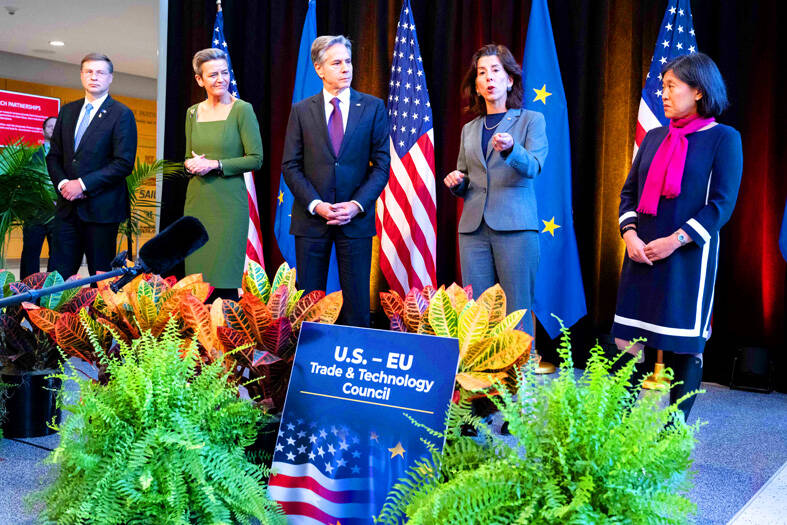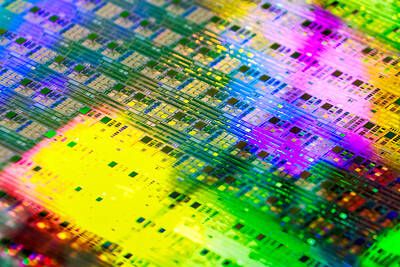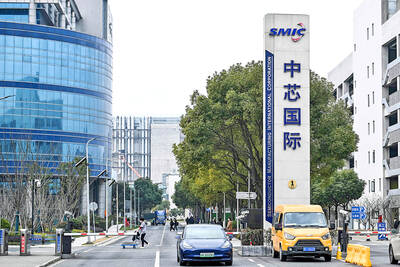The US and the EU are weighing new tariffs on Chinese steel and aluminum as part of a bid to fight carbon emissions and global overcapacity, people familiar with the matter said.
The move would mark a novel approach, as the US and the EU would seek to use tariffs — usually employed in trade disputes — to further their climate agenda.
US aluminum and steel producers climbed in extended trading, while in Hong Kong, Aluminum Corp of China (中國鋁業) and China Hongqiao Group Ltd (中國宏橋集團) slipped.

Photo: AFP
The idea, generated within US President Joe Biden’s administration, is still in an initial phase and has not been formally proposed, said the people, who asked not to be identified as the discussions are not public.
An agreement with the EU, including specifics on how to identify thresholds for applying tariffs, is not likely until late next year at the earliest, one of the people said, adding that even that timeline was optimistic.
The new framework, which builds on a related US-EU agreement last year, is mainly aimed at China, the world’s biggest carbon emitter and producer of steel and aluminum, as well as other large polluting nations, the people said.
The tariff plan would likely deepen divisions between Beijing and Washington, particularly at a time when the two countries have committed to working together to fight climate change.
However, talks between the US and the EU to jointly address the climate crisis are a positive sign for a relationship that is again suffering trade irritants, including Biden’s signature climate law that European countries say discriminates against their industries.
Other countries have expressed interest in joining the talks, but the new framework would likely not include them at first. That could mean steel and aluminum imports from Japan and others risk being targeted by new duties.
However, the goal is to open the deal to other countries as quickly as possible, as long as they can meet the agreement’s ambitions, one person familiar with the plans said.
It is unclear what legal authority the Biden administration would use to implement new tariffs. A person familiar with the matter said that question is still being worked out internally and in talks with the EU, as well as with industry representatives and the US Congress.
The White House is also talking to lawmakers about potential new authorities, the person added.
US Trade Representative (USTR) Katherine Tai (戴琪) and her team presented the idea to European Commissioner for an Economy that Works for People Valdis Dombrovskis and others in Prague in late October.
EU officials raised several questions at the time, including regarding the legality and compatibility with WTO rules, as well as with the bloc’s internal carbon pricing mechanism, people familiar with the talks said.
USTR General Counsel Greta Peisch gave the US presentation in Prague and is leading the charge from Washington, one person said.
A spokesperson for USTR declined to comment.
The climate-focused trade effort by the US and the EU was first raised in October last year, when the two sides resolved a key dispute over steel and aluminum tariffs that had been imposed by former US president Donald Trump on national security grounds.
One approach for the potential new tariffs might be to convert an existing investigation under Section 232 of the US Trade Expansion Act — which served as the underlying rationale for Trump’s duties on European steel and aluminum in 2018 — into a new inquiry that targets carbon emissions and overcapacity.
That would give the White House legal cover to move forward without having to wait for a new probe to conclude, another person said.
US officials are also still deliberating the tariff rate, or band of tariff rates that would be applied to other countries, and the US has told EU officials that they would like the agreement to be legally binding, the people said.
For the Biden administration, the first-of-its-kind agreement would be one element of what the White House describes as its worker-centric trade policy, as it focuses on defending key industries and their workers in the US and Europe.

SEMICONDUCTOR SERVICES: A company executive said that Taiwanese firms must think about how to participate in global supply chains and lift their competitiveness Taiwan Semiconductor Manufacturing Co (TSMC, 台積電) yesterday said it expects to launch its first multifunctional service center in Pingtung County in the middle of 2027, in a bid to foster a resilient high-tech facility construction ecosystem. TSMC broached the idea of creating a center two or three years ago when it started building new manufacturing capacity in the US and Japan, the company said. The center, dubbed an “ecosystem park,” would assist local manufacturing facility construction partners to upgrade their capabilities and secure more deals from other global chipmakers such as Intel Corp, Micron Technology Inc and Infineon Technologies AG, TSMC said. It

People walk past advertising for a Syensqo chip at the Semicon Taiwan exhibition in Taipei yesterday.

NO BREAKTHROUGH? More substantial ‘deliverables,’ such as tariff reductions, would likely be saved for a meeting between Trump and Xi later this year, a trade expert said China launched two probes targeting the US semiconductor sector on Saturday ahead of talks between the two nations in Spain this week on trade, national security and the ownership of social media platform TikTok. China’s Ministry of Commerce announced an anti-dumping investigation into certain analog integrated circuits (ICs) imported from the US. The investigation is to target some commodity interface ICs and gate driver ICs, which are commonly made by US companies such as Texas Instruments Inc and ON Semiconductor Corp. The ministry also announced an anti-discrimination probe into US measures against China’s chip sector. US measures such as export curbs and tariffs

The US on Friday penalized two Chinese firms that acquired US chipmaking equipment for China’s top chipmaker, Semiconductor Manufacturing International Corp (SMIC, 中芯國際), including them among 32 entities that were added to the US Department of Commerce’s restricted trade list, a US government posting showed. Twenty-three of the 32 are in China. GMC Semiconductor Technology (Wuxi) Co (吉姆西半導體科技) and Jicun Semiconductor Technology (Shanghai) Co (吉存半導體科技) were placed on the list, formally known as the Entity List, for acquiring equipment for SMIC Northern Integrated Circuit Manufacturing (Beijing) Corp (中芯北方積體電路) and Semiconductor Manufacturing International (Beijing) Corp (中芯北京), the US Federal Register posting said. The